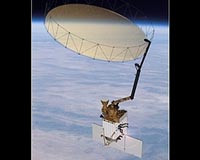| . |  |
. |
Irvine CA (SPX) Aug 17, 2009 Using satellite data, UC Irvine and NASA hydrologists have found that groundwater beneath northern India has been receding by as much as 1 foot per year over the past decade - and they believe human consumption is almost entirely to blame. More than 109 cubic kilometers (26 cubic miles) of groundwater disappeared from the region's aquifers between 2002 and 2008 - double the capacity of India's largest surface-water reservoir, the Upper Wainganga, and triple that of Lake Mead, the largest manmade reservoir in the U.S. People are pumping northern India's underground water, mostly to irrigate cropland, faster than natural processes can replenish it, said Jay Famiglietti and Isabella Velicogna, UCI Earth system scientists, and Matt Rodell of NASA's Goddard Space Flight Center. "If measures are not soon taken to ensure sustainable groundwater usage, consequences for the 114 million residents of the region may include a collapse of agricultural output, severe shortages of potable water, conflict and suffering," said Rodell, lead author of the study and former doctoral student of Famiglietti's at the University of Texas at Austin. Groundwater comes from the percolation of precipitation and other surface waters down through Earth's soil and rock, accumulating in aquifers - cavities and layers of porous rock, gravel, sand or clay. In some subterranean reservoirs, the water may be thousands to millions of years old; in others, water levels decline and rise again naturally each year. Groundwater levels do not respond to changes in weather as rapidly as lakes, streams and rivers do. So when groundwater is pumped for irrigation or other uses, restoration of original levels can take months or years. "Groundwater mining - that is when withdrawals exceed replenishment rates - is a rapidly growing problem in many of the world's large aquifers," Famiglietti said. "Since groundwater provides nearly 80 percent of the water required for irrigated agriculture, diminishing groundwater reserves pose a serious threat to global food security." Data provided by India's Ministry of Water Resources had suggested that groundwater use across the nation was exceeding natural replenishment, but the regional rate of depletion had been unknown. In the new study, the hydrologists analyzed six years of monthly data for northern India from twin satellites called GRACE - NASA's Gravity Recovery and Climate Experiment - to produce a chronology of underground water storage changes. GRACE detects differences in gravity brought about by fluctuations in water mass, including water below the Earth's surface. As the satellites orbit 300 miles above Earth, their positions change - relative to each other - in response to variations in the pull of gravity. They fly about 137 miles apart, and microwave ranging systems measure every microscopic variance in the distance between the two. "With GRACE, we can monitor water storage changes everywhere in the world from our desk," said Velicogna, also with NASA's Jet Propulsion Laboratory. "The satellites allow us to observe how water storage evolves from one month to the next in critical areas of the world." Groundwater loss in northern India is particularly alarming because there were no unusual trends in rainfall - in fact, it was slightly above normal during the study period. The researchers also examined data on soil moisture, lake and surface reservoir storage, vegetation and glaciers in the nearby Himalayas to confirm that the apparent groundwater trend was real. The only influence they couldn't rule out was human. "For the first time, we can observe water use on land with no additional ground-based data collection," Famiglietti said. "This is critical because in many developing countries, where hydrological data are both sparse and hard to access, space-based methods provide perhaps the only opportunity to assess changes in freshwater availability across large regions."
Share This Article With Planet Earth
Related Links University of California - Irvine Water News - Science, Technology and Politics
 Helping JPL Map Soil Moisture Globally
Helping JPL Map Soil Moisture GloballyCarpinteria CA (SPX) Aug 14, 2009 A deployable satellite reflector and boom assembly from Northrop Grumman will help NASA's Jet Propulsion Laboratory (JPL) map soil moisture and the freezing and thawing cycles globally with unprecedented accuracy, resolution and coverage. The company's AstroMesh-Lite configuration deployable reflector will be used on JPL's Soil Moisture Active/Passive (SMAP) mission targeted for launch in ... read more |
|
| The content herein, unless otherwise known to be public domain, are Copyright 1995-2009 - SpaceDaily. AFP and UPI Wire Stories are copyright Agence France-Presse and United Press International. ESA Portal Reports are copyright European Space Agency. All NASA sourced material is public domain. Additional copyrights may apply in whole or part to other bona fide parties. Advertising does not imply endorsement,agreement or approval of any opinions, statements or information provided by SpaceDaily on any Web page published or hosted by SpaceDaily. Privacy Statement |